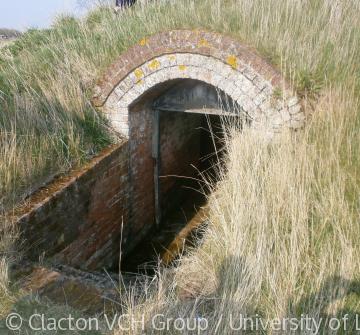The Beaumont Quay Lime Kiln

Beaumont Quay and similar landing places along the Essex coast were chiefly used for the export of local agricultural produce to London. However, the barges also brought back return cargoes and these were mainly building materials (such as stone, flint or bricks) or soil improvers such as manure and chalk (limestone). The manure was collected in London (both from the capital’s horses and human ‘night soil’) and the chalk on the return journey from quarries along the Thames estuary in both Essex and Kent. The main reason that farmers wanted to apply chalk was to correct high levels of acidity in the soil and therefore improve the uptake of major plant nutrients such as nitrogen and to maximise crop yields. It could also provide a source of calcium and magnesium for growing plants.
Although the chalk could simply be spread on the farmland it was more efficient burn the chalk at high temperature in a kiln which led to the release of carbon dioxide and created a product called ‘quicklime’. When the ‘quicklime’ was mixed with water (a process known as ‘slaking’) it was turned into a stable powder form of lime which could then be spread on the land. The use of lime for agricultural purposes was described in Sir Anthony Fitzherbert's Boke of Husbandrye, in 1523, but these activities became increasingly important during the age of agricultural improvement in the 18th and 19th centuries. There was also demand for lime for use in lime mortars in the building industry in the 19th century.
Lime kilns were therefore a natural addition to the facilities alongside many of the small Essex quays, wharves and landing places. Although many were built only a few have survived, and the kiln at Beaumont Quay is built to an East Anglian (mixed-feed) design which is fairly rare. It is a circular red brick building within an earthen mound, and is some 2.5 metres high and about 13 metres in diameter. From the main entrance you can access a barrel-vaulted circulation passage around a central combustion chamber. On the other side of the mound another smaller rectangular opening was probably a ventilator that allowed the operators to regulate the draught to the kiln. The central combustion chamber had an opening for lighting the kiln, two others for raking out the lime and ash. The kiln was fired with wood and coal, and alternative layers of fuel and chalk would be added from outside via the opening at the top of the kiln. The chalk would turn to lime at about 900° C and fall to the bottom of the kiln where it could be raked out. The kiln was probably in continuous use, and the quay would have large heaps of chalk and coal ready for processing.
Sources:
J. Moore, ‘Beaumont Quay’, Colchester Archaeological Group Bulletin, 54 (2014), pp. 8–12.
English Heritage Listing: Beaumont Quay, Hamford Water: a 19th century quay and lime kiln. List entry Number: 1020688 (See: http://list.historicengland.org.uk/)
Content derived from research undertaken as part of the Victoria County History project




